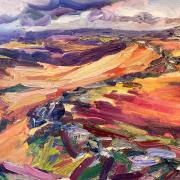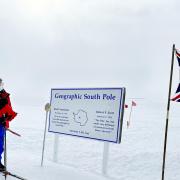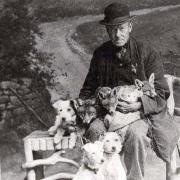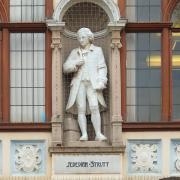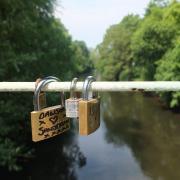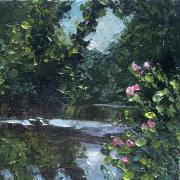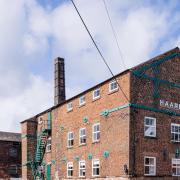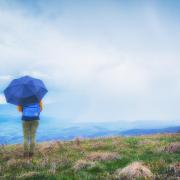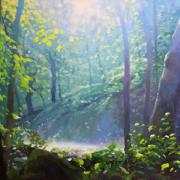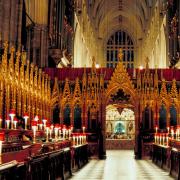Next year marks the 250th anniversary of Captain James Cook’s arrival in Australia. John Wright tells the tale of the country’s most famous castaway who may, or may not, have had local connections.

If it had not been for the words 'was born perhaps in Derbyshire' dangled so tantalisingly in front of me, I may have kept looking elsewhere for a story. Instead, like Alice in Wonderland, the possibility tempted me to disappear down a rabbit hole and up one side-tunnel after another only to conclude that it will be a researcher far more able than me who discovers conclusively whether Australia's most famous castaway did or did not hail from Derbyshire.
Had the suggestion appeared anywhere but in a country's own official record of its history, the Australian Dictionary of Biography (Eliza Fraser's entry written by historian Dr Elaine Brown) it would have been easier to dismiss. Unfortunately, despite being armed with Brown's unequivocal statement that 'her maiden name was Slack', my thrill at finding with Derbyshire Record Office's help a 1st June 1798 baptism entry for an Elizabeth Slack from St Mary's Church, Wirksworth (born 30th October 1797) 'daughter of John and Grace of Middleton [-by-Wirksworth]' was tempered by finding another family website saying she had married someone other than Captain James Fraser. Even Wikipedia's Eliza Fraser listing beguiled me with 'born Wirksworth' but quoted no source.
Eliza has proved so elusive that even her name varies depending on where you look, although the helpful Orkney Family History Society tracked down a parish register in Greenock, Scotland showing that her second child (unless he was Eliza's stepson), James Muir Frazer (yes, z not s!), was born there on 8th June 1825, her parents 'Captain James Frazer shipmaster and Eliza Ann Britton,' another possible maiden name to pursue. It also produced the full names of James Muir's nine future children (the second named Annie Britton Fraser), four of whom (plus both parents) are inscribed on a gravestone I traced to Dunedin in New Zealand where Eliza seems finally to have made her home.
Eliza Fraser was 37 and pregnant when she left London with her sick husband, 54-year-old Captain James Fraser, on his ship, the Stirling Castle, on 22nd October 1835, leaving in Stromness, Orkney, their three children - Jane, 15, James Muir, 10, and David, 6 - with local Presbyterian minister, Reverend Peter Learmonth. The last thing she would have imagined is that seven months later they would be shipwrecked on Australia's Great Barrier Reef and that her baby would be born and die in a longboat after abandoning ship.

The following May, the Stirling Castle left Sydney after landing its supplies for the colony of rum, wine, beer, vinegar, mustard, pickles, salt, millstones and planks, and was now heading to Singapore past Moreton Bay (Brisbane) into more dangerous waters when it ran aground on Swain Reefs.
Nineteen people got into two boats with oars and sails. In the leaking longboat was Captain Fraser, Eliza, Fraser's 13-year-old nephew, John Fraser, chief officer Charles Brown and sailors Joseph Corralis, James Major, John Allan, Michael Doyle, Robert Darge, Michael Denny and Robert Carey. In the pinnace was second mate John Baxter with boatswain Edward Stone, Jacob Schofield, Robert Hodge, Robert Dayman, Henry Youlden, William Elliot and 17-year-old cabin-boy, John Wilson.
They divided their supplies - bread, salt beef, pork, brandy, butter, tripe, beer, clothes, weapons, sextants, chronometers, an axe - but found no water and headed for the mainland 150 miles away, the nearest settlement being Moreton Bay 370 miles south. On Day 3 Eliza Fraser went into labour. Her baby was delivered under water and died soon afterwards. On Day 5 they came to a small island where Eliza climbed a cliff and found water by lowering her shirt into a crack, wringing out enough for their containers and stopping Youlden from trying to drink more than his share. Some changed boats.
Soon the water ran out. Eliza managed to drink sea-water but the men tried it and were sick. One day, the longboat anchored so the pinnace could go and find water but it never returned, so they left. It took them a month to reach land. Running out of food, they prized limpets off rocks at low tide, and were without food and water for another week before sighting land. On the beach five aborigines with spears watched them arrive, the Badtjala people, and approached them with decomposing kangaroo meat. When a sailor ate some they took some of his clothing.

Despite being safer together, Darge, Youlden, Dayman, Denny, Elliot and Carey set off down the beach for Moreton Bay, unaware that they were not on the mainland but an 80-mile long tropical island. The rest headed south one night, Fraser, Eliza, John, Brown, Baxter and Doyle with firearms and Corralis with a big stick. Becoming separated, in the morning four were surrounded by aborigines who dug a hole in the sand and sweetened the water that seeped into it with leaves from a gorse-like shrub.
They wanted Baxter's jacket and when he refused they hit him with clubs. Their dwindling numbers made the aborigines bolder and the exchange of clothing continued until they were naked. The men were led away, leaving Eliza naked apart from some trailing sea-grape plant she tied round her waist. Aboriginal women took her to their camp, prodded her and pulled her hair. They gave her a baby to breast-feed as its mother was sick and painted her body with charcoal and lizard grease to make her skin darker.
To find bees' nests 'they tried to make her climb trees,' Michael Alexander wrote in Mrs Fraser on the Fatal Shore. 'When she couldn't, they would put fire sticks to her legs and bottom.' She refused the food they offered her (snake, lizard or witchetty grubs) and ate only fern root, entrails and fish scraps. She had to find mussels and mud-crabs, and they beat her if she didn't. Eliza slept naked on the ground by the fire covered with leaves.
Five weeks later she saw her husband trying to drag a log when an unsuccessful aboriginal hunting party returned and speared him. Eliza later said: 'I was horrified to see it emerge several inches through his chest. I pulled the spear from his body and from his mouth an immense quantity of blood spouted, and he died.' Brown and Denny were tied to a stake and burnt. 'Brown lay under a powerful sun,' she said, 'and called me to come and kill him. I endeavoured to carry him water in my hat, but was beaten.' The six who'd run away were also found and burnt, others taken to the mainland. Two sailors tried to swim away and were eaten by sharks.

As Eliza's ordeal reached its third month, two survivors were found on another island by Lieutenant Charles Otter of the ramshackle Moreton Bay penal settlement. Held there was a 33-year-old Irish convict, John Graham. Originally transported to New South Wales at 24 for stealing hemp, he had escaped from Moreton Bay before turning up again six years later just before his sentence expired, thinking they would free him. Instead they jailed him for another four years. When aborigines started arriving from the bush to talk to Graham, the commandant Captain Foster Fyans sensed that something extraordinary must have happened to Graham during his absence.
Like Eliza Fraser, he too had been living with aborigines, only for six years. Graham told him how he had been confronted by aborigines who 'immediately identified him as Moilow, a recently deceased elder,' DJ Mulvaney wrote in Irish Convict Lives, 'and he thereby acquired a ready-made family with two sons.' News came that Graham's aborigines had captured the castaways, confirmation coming when Otter, on a hunting trip, found Darge, Corralis and Youlden.
Graham volunteered and led the rescue party. He stripped off his clothes and greased himself and left with some bread and a potato. 'He was soon welcomed back amongst his people,' Mulvaney wrote. 'Around the fire that night he learned of the presence of two "young ghosts" across Lake Cooroibah. He offered tomahawks to whoever would fetch them, saying that they were his sons.
The next morning Graham set off. Needing to cross the sea, he repaired an old bark canoe with mud, and after walking six miles found Baxter and promised tomahawks and sugared water to the aborigines guarding him if they caught fish for them to eat, which they did. Graham went on alone along the beach for the 40 miles he guessed it would be. That night he camped and roasted a snake.

The next day he headed inland through the bush, and aborigines got closer. One told him that Eliza had been claimed by an aborigine Mothervane who said she was the spirit of his wife's sister. Graham told them Eliza was his dead wife Mamba. It was now 26 hours since he'd left Otter at the boats. His aboriginal 'sons' helped convince them that Graham was Moilow not a white man. But would they let him walk out with Eliza?
Unaware of this, Eliza looked up to see a naked stranger. 'Around her loins were part of the legs and waistband of a pair of trousers, which covered part of her thighs, wound round with Vines,' Graham said later. When he spoke to the aborigines they started shouting but didn't try to stop him as he led Eliza away. They reached Otter but still had 30 miles to walk to reach the boats. They carried Eliza, aborigines following, their numbers and rowdiness increasing as they went. They had changed their minds and at night threw boomerangs at them. One man was speared to death but the rest survived the night, reached the boats and ran them straight out into the sea.
Tales came in later from two survivors about the fate of the others, Hodge talking about cannibalism. Captain Roach sailed from Sydney to Moreton Bay and found in a clearing the remains of a white man whose head had been placed on a fire. The headless corpse was unrecognizable, the waistcoat it was wearing James Major's. When it was realised that the aborigines would not have left the gilt buttons, Hodge himself was suspected. Not knowing the land, how could any of these men have survived for months without turning to cannibalism?
Eliza Fraser recuperated in Moreton Bay where Doctor Kinnear Robertson reported that 'she was obsessed with the idea that she was pregnant', but she wasn't. Eliza arrived in Sydney on 15th October 1836, where she stayed at the home of the Colonial Secretary of New South Wales. Sympathy for her caused gifts and money to start arriving from the public and she was treated like a celebrity. Her rescuer, Graham, made it clear that all he wanted was his freedom, and in the absence of records, historians assume he was granted it. When the press came clamouring for his attention he seems to have slipped quietly away.

While Eliza waited in Sydney for a ship to return to Orkney, a brig, the Mediterranean Packet arrived. Not long after meeting its captain, Alexander John Greene, he and Eliza were secretly married at St Andrew's Scots Church in Sydney on 3rd February 1837 (two FamilySearch marriage records showing her full name as Eliza Anne Starke - suggesting possible misread handwriting of 'Slack' - or Fraser or Frazer), the ship sailing with them for England on 16th February, arriving in Liverpool on 16th July. Eliza sought financial help in England but was criticised in the press for not declaring that she was remarried to someone who seemed well off. Nonetheless, the public raised a further £482 (£40,000 today) which London's Lord Mayor sent to her Orkney church to ensure that it was mainly spent on her children.
Eliza and Alexander settled in Stromness and were still living there in 1838 when the Sheriff Substitute of Orkney received a report of 'threats of violence' against them by William Taylor and Clementina Mellish, both 'cautioned under penalty of 40 shillings.' The Orkney archives department told me that 'there is no mention of them in the 1841 Census for Stromness. It's possible they had left because they were being harassed.'
It seems that they sailed for a life in New Zealand far from the madding crowd where Eliza, wherever she came from, may well have found heaven with her second husband after her first, unwittingly, had taken her into hell.






